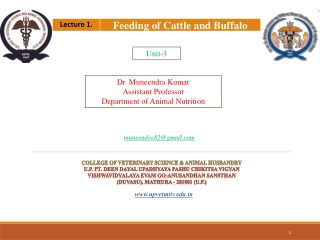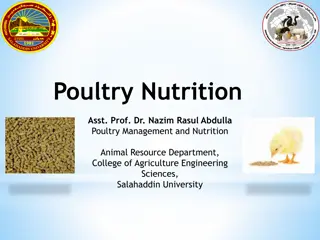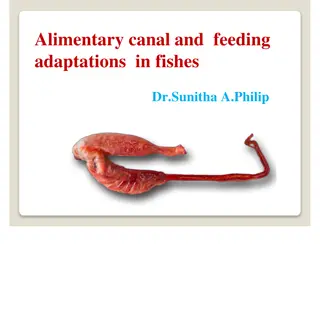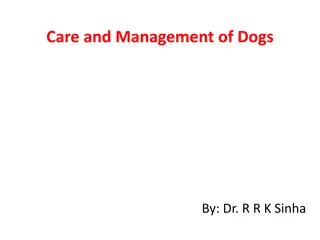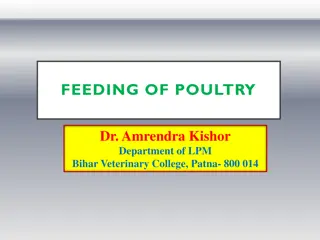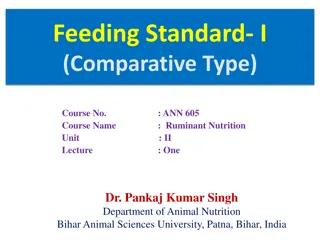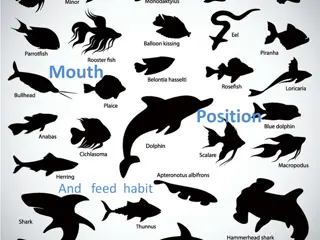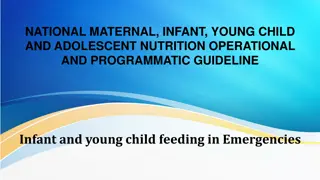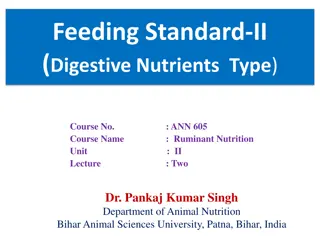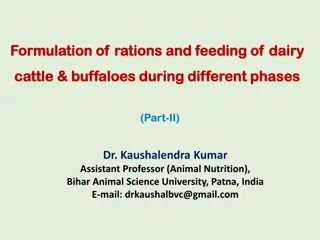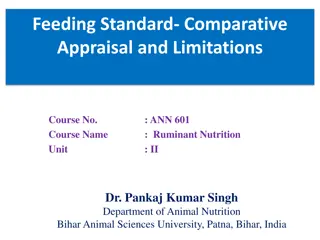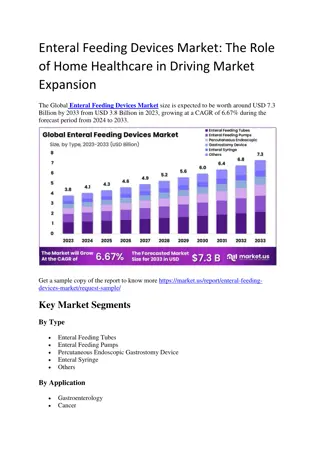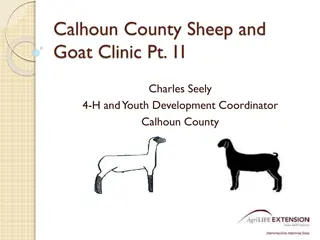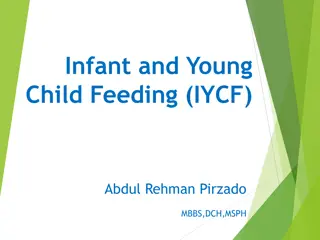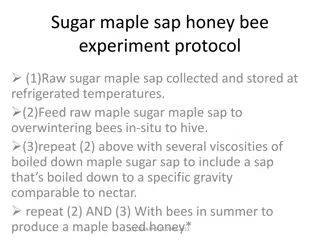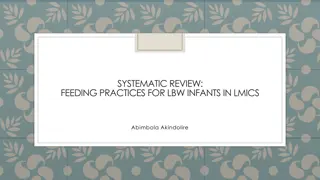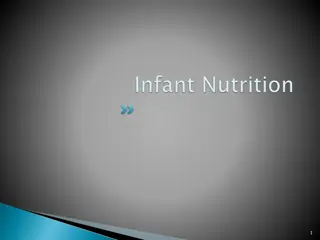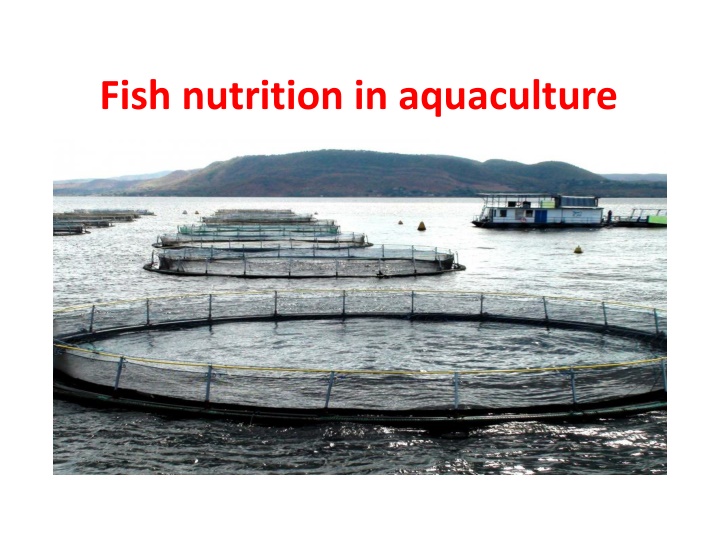
Understanding Fish Nutrition in Aquaculture
Aquaculture involves the farming of various aquatic organisms, including fish, molluscs, crustaceans, and aquatic plants. This article explores the differences between nutrition and feeding of fish and land animals, highlighting the specific dietary needs of fish, their digestive morphology, and the importance of appropriate fish food properties for optimal feeding in water environments.
Download Presentation

Please find below an Image/Link to download the presentation.
The content on the website is provided AS IS for your information and personal use only. It may not be sold, licensed, or shared on other websites without obtaining consent from the author. If you encounter any issues during the download, it is possible that the publisher has removed the file from their server.
You are allowed to download the files provided on this website for personal or commercial use, subject to the condition that they are used lawfully. All files are the property of their respective owners.
The content on the website is provided AS IS for your information and personal use only. It may not be sold, licensed, or shared on other websites without obtaining consent from the author.
E N D
Presentation Transcript
Fish nutrition in aquaculture Aquaculture The Farming of aquatic organisms including fish, molluscs, crustceans, and aquatic plants. Total aquaculture production in 1990 was just over150 million tones. Historically, Asia is considered to be the cradle of aquaculture. Asia contribute about 85% of the total production followed by Europe (about 7-10%). Approximately 150 countries in the world are known to have some sort of aquaculture activity. China is leading producer of all aquaculture commodities, it had long history and tradition of utilizing its water resources and fish species.
Differences between nutrition and feeding of fish and land animals Fish need proteins, essential fatty acids, minerals, vitamins and energy sources. Energy requirements are relatively lower than warm land animals Fish have higher protein to energy ratio. Ability of fish to absorb certain minerals such as calcium from water surrounding them reduce the dietary needs for these minerals. Some fish have a limited ability to synthesize vitamin C and must depend on dietary sources.
Differences between nutrition and feeding of fish and land animals Fish food must have specific physical properties that facilitate feeding in water. It may be desirable that food either float or sink in water but it should not disintegrate before being consumed. Nutrient should be stable and not leached away. Particle size must be appropriate for the species. Minimum food waste so as not adversely affect dissolved oxygen and water quality.
Digestive morphology Mouth Esophagus Stomach Intestine Rectum Secretory gland ( liver and pancreas) retention time- 6-8 hr
Mouth - -Collection point of food Collection point of food - -Teeth and tentacles for grabbing Teeth and tentacles for grabbing Jaws that project forward to engulf the prey Jaws that project forward to engulf the prey Teeth or special apparatus for grinding ( Teeth or special apparatus for grinding (omnivorous omnivorous & &herbivorous) herbivorous) Gill rakes and mucus to collect phytoplankton Gill rakes and mucus to collect phytoplankton Pumping devices to move water and filter Pumping devices to move water and filter phytoplankton phytoplankton
Mouth Channel cat fish: large mouth/esophagus, for capturing the prey, mouth has small teeth Common carp: small mouth for bottom feeding, pharyngeal teeth. Tilapias : intermediate of bottom feeders, predators, efficient plankton feeders, use gill rakers, pharyngeal mucus
Esophagus Generally short Circular and longitudinal muscles to assist in swallowing, mucus to lubricate Predatory fish the esophagus is distensible to allow the swallowing of large preys
Stomach True : salmonids, catfish, tilapias, eels HCL released by parietal cells PH 1.5-3 Pepsinogen released by specialized cells Activated by HCL, hydrolyses it to pepsin - no true stomach (carp) No area of gastric secretion
Intestine Differentiation depends on species and feeding habits ( clear division and simple tubes) -digestion of emulsified foods -absorption of most of the nutrients - recovery of water and enzymes - discharge of physiological wastes
Intestine Channel catfish: length less than whole body Common carp: digestive system is 3x whole body length. Tilapia :tract is 6-8 x that of body length Shrimp: short mid gut with midget gland (used for absorption/ secretion/storage of nutrients, enzymes) intestine length less than body
Requirements for fish Energy Proteins Lipids Vitamins minerals
Role of protein Bulk composition of the body (structural aspects of the cells) Oxidative metabolism ( used as energy sources) Enzymes Plasma proteins hormones
Special functions Peptides (formation of proteins) Purines/pyrimidins (control ofproteins synthesis) Histamines Conjugated proteins (assist in excretion of other compounds) Pigments ( melanin, drived from amino acids
Proteins and amino acids Amino acids can be divided into two categories Non-essential amino acids: synthesized by animal bodies Essential amino acids: those the fish cannot synthesize in sufficient quantity to support maximum growth
Essential amino acids Methionine, Arginine, Threonine, Tryptophan, Histidine, Isoleucine, lysine, leucine, Valine and Phenyl alanine
Protein and amino acids requirements for fish Factors affecting proteins and amino acids requirements: 1-fish age is an important factors, amino acids, protein requirements decrease as the fish grow. 2-environmental factors; changes in water temperature affect protein requirements of fish. Protein requirements are lower for herbivorous fish and omnivorous fish than they are for carnivorous fish, and are higher for fish reared in high density (recirculating aquaculture) than low density (pond aquaculture) systems.
Protein deficiency Reduced growth Poor feed conversion Reduced appetite Cataracts (methionine) Scoliosis (tryptophan), lateral curvature of the vertebral column. caudal fin rot (lysine).
Estimated dietary protein requirement in for maximal growth species Protein% 45 32-36 31-38 30 40 41-43 Atlantic salmon Channel cat fish Common carp Nile tilapia Rainbow trout Grass carp

